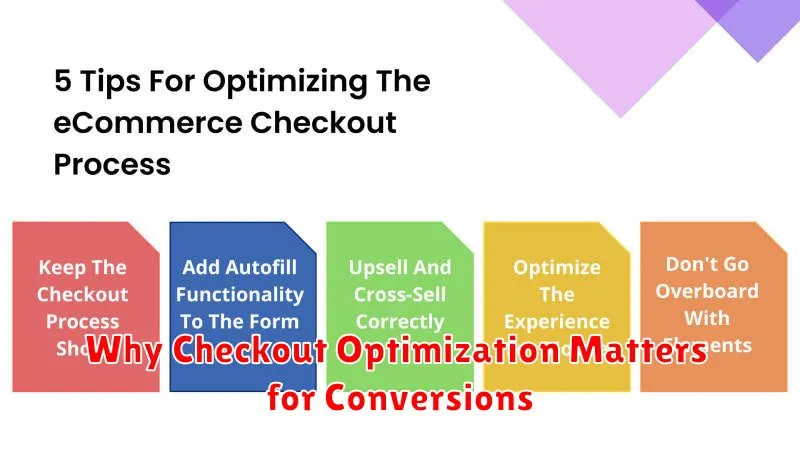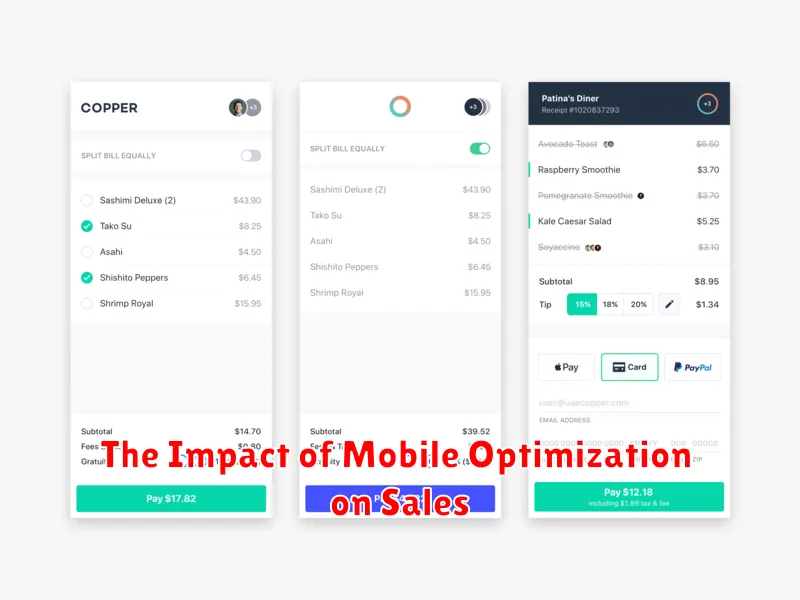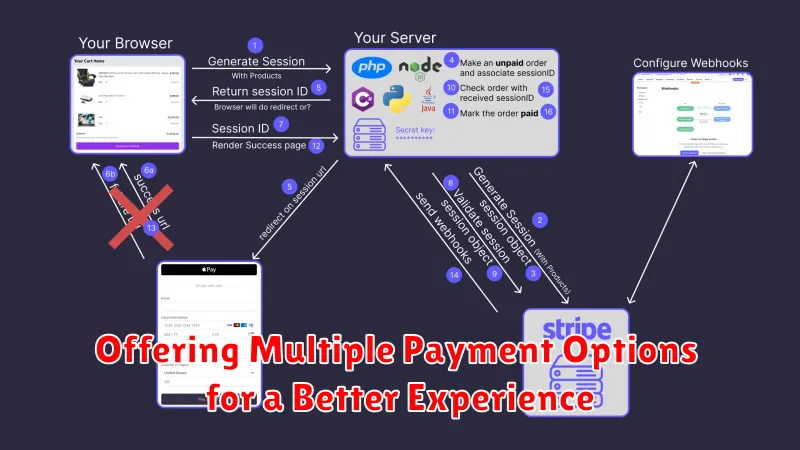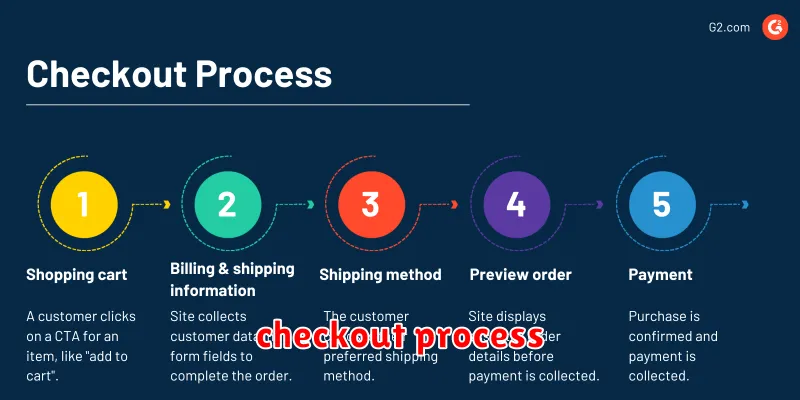Are you losing potential sales due to a cumbersome e-commerce checkout process? A streamlined and optimized checkout experience is crucial for boosting conversion rates and increasing your revenue. This guide will explore proven strategies to improve your online store’s checkout, minimizing cart abandonment and maximizing customer satisfaction. Learn how to implement simple yet effective changes that will significantly impact your e-commerce business‘s bottom line. Discover the secrets to a frictionless checkout flow that converts browsers into buyers.
Why Checkout Optimization Matters for Conversions

A streamlined checkout process is crucial for maximizing conversions in e-commerce. A complex or frustrating checkout experience can lead to cart abandonment, a significant loss of potential sales. Optimization focuses on removing friction points, improving user experience, and ultimately encouraging customers to complete their purchases.
Improved conversion rates directly translate to increased revenue. By simplifying the checkout process, you reduce the number of steps a customer needs to take to finalize their order. This reduction in effort significantly increases the likelihood of a completed purchase. A well-optimized checkout contributes to a positive brand perception, fostering customer loyalty and repeat business.
Furthermore, data gathered from a well-designed checkout process allows for data-driven decision-making. Analyzing metrics such as cart abandonment rates and conversion funnels provides valuable insights into areas for further improvement. This continuous optimization loop ensures ongoing growth and maximizes the return on investment (ROI) of your e-commerce platform.
How to Simplify the Checkout Process for Customers
A streamlined checkout process is crucial for boosting sales and improving the customer experience. Reducing friction at this stage is key to converting potential buyers into paying customers.
Minimize required fields: Only ask for essential information like email address, shipping address, and payment details. Avoid unnecessary fields that could deter customers.
Offer guest checkout: Allow customers to purchase without creating an account. This reduces steps and speeds up the process for those who prefer not to register.
Provide clear order summaries: Display a concise summary of the order, including item details, shipping costs, and taxes, before the final confirmation. This helps to avoid confusion and abandoned carts.
Use a secure payment gateway: Employ a reputable and secure payment gateway that instills customer confidence and ensures secure transactions. Display security badges to reassure buyers.
Optimize for mobile devices: Ensure your checkout process is fully responsive and functions seamlessly across all devices, particularly smartphones and tablets, as many customers shop using mobile devices.
Implement progress indicators: Use progress bars or other visual cues to show customers how far along they are in the checkout process, increasing transparency and reducing anxiety.
Offer multiple payment options: Provide a variety of payment options, including credit cards, debit cards, PayPal, and other popular digital wallets, to cater to diverse customer preferences.
By implementing these strategies, you can significantly simplify your checkout process, leading to increased conversions and a more positive customer experience. Regularly test and analyze your checkout flow to identify areas for further improvement.
The Impact of Mobile Optimization on Sales

Mobile optimization is no longer optional for e-commerce businesses; it’s essential. A significant portion of online shopping now occurs on smartphones and tablets. Failing to optimize your checkout process for mobile devices leads to a higher cart abandonment rate and consequently, lower sales.
Responsive design is crucial. Your website must adapt seamlessly to different screen sizes, ensuring a smooth and user-friendly experience on all devices. Easy navigation, clear call-to-actions, and a simplified checkout flow are key to converting mobile shoppers into paying customers. A poorly optimized mobile experience can lead to frustration and lost sales.
Conversely, a well-optimized mobile checkout process directly impacts your bottom line. By prioritizing mobile usability, you improve the customer experience, reduce friction, and ultimately, increase sales conversions. Investing in mobile optimization is an investment in growth and revenue generation for your e-commerce business.
How to Reduce Cart Abandonment Rates
High cart abandonment rates significantly impact e-commerce sales. Optimizing the checkout process is crucial to minimize this. Focus on streamlining the experience to make it as frictionless as possible for customers.
Simplify the checkout process: Minimize the number of steps and fields required. Offer guest checkout options to avoid mandatory account creation. Clearly display the total cost, including shipping and taxes, upfront.
Build trust and security: Display trust badges from reputable security providers (like Verisign or McAfee) to reassure customers about the security of their transactions. Clearly state your return policy and provide excellent customer support.
Offer multiple payment options: Accept a variety of payment methods including credit cards, debit cards, PayPal, and other popular digital wallets. This caters to diverse customer preferences and increases convenience.
Provide progress indicators: Use progress bars or other visual cues to guide customers through the checkout process, creating a sense of transparency and control. This reduces uncertainty and frustration.
Offer incentives: Consider offering discounts, free shipping, or other incentives to encourage customers to complete their purchases. These can be highly effective in persuading hesitant buyers.
Optimize for mobile: Ensure your checkout process is fully responsive and optimized for mobile devices. Many customers shop on smartphones, and a poor mobile experience can lead to abandonment.
Regularly test and analyze: Continuously monitor your cart abandonment rate and A/B test different elements of your checkout process to identify areas for improvement. Use analytics tools to track user behavior and pinpoint bottlenecks.
Offering Multiple Payment Options for a Better Experience

Offering a variety of payment options is crucial for optimizing your e-commerce checkout process and boosting sales. Convenience is key; customers are more likely to complete a purchase if they can pay using their preferred method.
Consider including options like credit cards (Visa, Mastercard, American Express, Discover), debit cards, PayPal, Apple Pay, Google Pay, and even buy now, pay later (BNPL) services, depending on your target audience and business model. The more options you provide, the broader your customer reach.
Clearly displaying available payment methods on your checkout page is essential. Use clear icons and easily understandable descriptions to avoid confusion. Ensure that the process is secure and complies with all relevant data protection regulations to build customer trust and confidence.
By providing a range of secure and convenient payment options, you significantly reduce cart abandonment rates and improve the overall customer experience, ultimately leading to increased sales. Analyzing your payment data can also help you determine which methods are most popular with your customers, allowing you to further optimize your offering.
Using Trust Signals to Increase Buyer Confidence
A smooth checkout process is crucial, but building trust is equally vital for boosting sales. Customers need reassurance before committing to a purchase. Employing strong trust signals significantly improves conversion rates.
Displaying security badges from reputable providers like McAfee or Norton reassures customers that their information is safe. Clearly showing your HTTPS protocol (the padlock icon in the browser) is a fundamental trust signal.
Customer reviews and testimonials are powerful social proof. Showcase positive feedback prominently on your checkout page. A simple display of a star rating or a few short, impactful reviews can significantly impact buyer confidence.
Transparency in pricing and fees is key. Avoid hidden charges and clearly display all costs upfront, including shipping and taxes. This prevents unexpected costs that could deter customers from completing their purchase.
Contact information readily available on your checkout page builds trust. Providing a phone number, email address, and physical address demonstrates your legitimacy and willingness to assist.
Guarantees and return policies are critical. Clearly stating your return policy and offering a money-back guarantee can significantly reduce buyer hesitation. This demonstrates confidence in your product and a commitment to customer satisfaction.
By strategically incorporating these trust signals, you create a secure and reliable checkout experience, leading to increased buyer confidence and ultimately, higher conversion rates.
How to Implement One-Click Checkout Solutions
Implementing a one-click checkout solution significantly streamlines the purchasing process, leading to increased conversion rates. The core of this involves integrating a payment gateway that supports saved payment information and addresses. Secure storage of customer data is paramount, adhering to all relevant data privacy regulations (like PCI DSS).
Choosing the right platform is crucial. Many e-commerce platforms offer built-in one-click checkout features or integrations with third-party providers. Consider factors such as cost, ease of integration, and available features when making your selection. Thorough testing is essential before launch.
The implementation process typically involves: 1) Selecting a payment gateway; 2) Configuring the gateway’s API with your e-commerce platform; 3) Implementing secure customer data storage; 4) Thoroughly testing the functionality across various browsers and devices; and 5) Clearly communicating the one-click checkout option to customers.
Remember to clearly communicate the benefits of one-click checkout to your customers during the checkout process. Highlight the speed and convenience, reassuring them about the security of their information. This will encourage adoption and maximize the positive impact on your sales.
Measuring and Improving Checkout Performance
Optimizing your e-commerce checkout process is crucial for boosting sales. Measuring checkout performance is the first step. Key metrics include cart abandonment rate, average checkout time, and conversion rate. Tools like Google Analytics and dedicated e-commerce analytics platforms provide this data.
Once you have this data, you can identify bottlenecks. Is the checkout process too long? Are there confusing steps? Are there too many required fields? A/B testing different checkout designs can pinpoint areas for improvement. For example, testing different button placements or simplifying the form fields.
Improving checkout performance involves addressing these bottlenecks. Streamline the process by reducing the number of steps. Offer guest checkout options to minimize form filling. Implement clear and concise instructions and ensure a mobile-friendly design. Consider using a progress bar to provide visual cues. Regular monitoring and iterative improvements based on your data analysis is vital for sustained success.
By focusing on these metrics and making data-driven improvements, you can significantly reduce cart abandonment, shorten checkout times, and ultimately increase your conversion rates, leading to higher sales.

